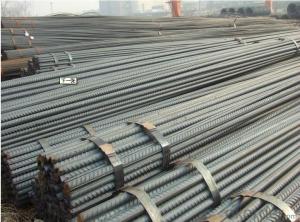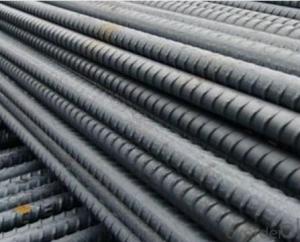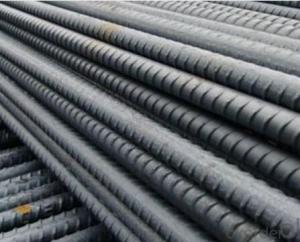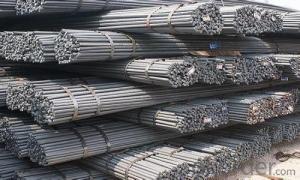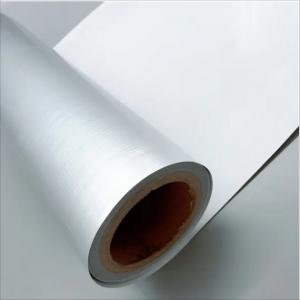Reinforcing Bar Deformed Bar BS4449-1997/2009 or GB HRB400 6mm-50mm
- Loading Port:
- China Main Port
- Payment Terms:
- TT or LC
- Min Order Qty:
- -
- Supply Capability:
- -
OKorder Service Pledge
OKorder Financial Service
You Might Also Like
Product Description:
OKorder is offering high quality Deformed Bar BS4449-1997/2009 or GB HRB400 6MM-50MMat great prices with worldwide shipping. Our supplier is a world-class manufacturer of steel, with our products utilized the world over. OKorder annually supplies products to European, North American and Asian markets. We provide quotations within 24 hours of receiving an inquiry and guarantee competitive prices.
Product Applications:
Deformed bar is widely used in buildings, bridges, roads and other engineering construction. Big to highways, railways, bridges, culverts, tunnels, public facilities such as flood control, dam, small to housing construction, beam, column, wall and the foundation of the plate, deformed bar is an integral structure material. With the development of world economy and the vigorous development of infrastructure construction, real estate, the demand for deformed bar will be larger and larger
Product Advantages:
OKorder's Deformed Bar BS4449-1997/2009 or GB HRB400 6MM-50MMare durable, strong, and resist corrosion, exact size, regular package, chemical and mechanical properties are stable.
Main Product Features:
· Premium quality
· Prompt delivery & seaworthy packing (30 days after receiving deposit)
· Corrosion resistance
· Can be recycled and reused
· Mill test certification
· Professional Service
· Competitive pricing
Product Specifications:
Manufacture: Hot rolled
Grade: BS4449
Certificates: ISO, SGS, BV, CIQ
Diameter: 6mm,8mm,10mm,12mm,14mm,16mm,18mm,20mm,
22mm,25mm,28mm,32mm,36mm,40mm,50mm
Length: 6M, 9M,12M or as required
Packaging: Export packing, nude packing, bundled
Chemical Composition: (Please kindly find our chemistry of our material based on HRB500 as below for your information)
Grade | Technical data of the original chemical composition (%) | ||||||
C | Mn | Si | S | P | V | ||
HRB400 | ≤0.25 | ≤1.60 | ≤0.80 | ≤0.045 | ≤0.045 | 0.04-0.12 | |
Physical capability | |||||||
Yield Strength (N/cm²) | Tensile Strength (N/cm²) | Elongation (%) | |||||
≥400 | ≥570 | ≥14 | |||||
Theoretical weight and section area of each diameter as below for your information:
Diameter(mm) | Section area (mm²) | Mass(kg/m) | Weight of 12m bar(kg) |
6 | 28.27 | 0.222 | 2.664 |
8 | 50.27 | 0.395 | 4.74 |
10 | 78.54 | 0.617 | 7.404 |
12 | 113.1 | 0.888 | 10.656 |
14 | 153.9 | 1.21 | 14.52 |
16 | 201.1 | 1.58 | 18.96 |
18 | 254.5 | 2.00 | 24 |
20 | 314.2 | 2.47 | 29.64 |
22 | 380.1 | 2.98 | 35.76 |
25 | 490.9 | 3.85 | 46.2 |
28 | 615.8 | 4.83 | 57.96 |
32 | 804.2 | 6.31 | 75.72 |
36 | 1018 | 7.99 | 98.88 |
40 | 1257 | 9.87 | 118.44 |
50 | 1964 | 15.42 | 185.04 |
FAQ:
Q1: Why buy Materials & Equipment from OKorder.com?
A1: All products offered byOKorder.com are carefully selected from China's most reliable manufacturing enterprises. Through its ISO certifications, OKorder.com adheres to the highest standards and a commitment to supply chain safety and customer satisfaction.
Q2: How do we guarantee the quality of our products?
A2: We have established an advanced quality management system which conducts strict quality tests at every step, from raw materials to the final product. At the same time, we provide extensive follow-up service assurances as required.
Q3: How soon can we receive the product after purchase?
A3: Within three days of placing an order, we will begin production. The specific shipping date is dependent upon international and government factors, but is typically 7 to 10 workdays.

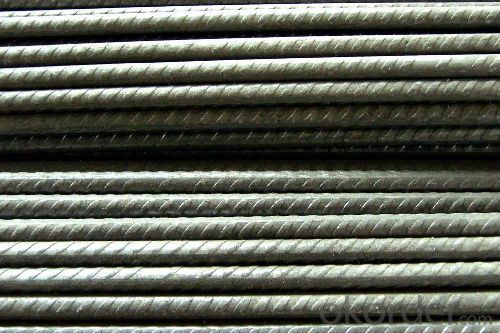
- Q:What does "4EDT6" mean on thread steel?
- It is a long strip of steel with a hollow cross section. It can be divided into round tube, square tube, hexagonal tube and all kinds of special-shaped section steel tube according to its sectional shape. According to the different processing technology, seamless steel pipe and welded pipe can be divided into two categories.
- Q:Can steel rebars be used in structures with curved or irregular shapes?
- Yes, steel rebars can be used in structures with curved or irregular shapes. The flexibility and malleability of steel allow rebars to be bent and shaped according to the desired design, making it suitable for various architectural and engineering applications.
- Q:What are the different types of steel rebars used in earthquake-prone regions?
- In earthquake-prone regions, several types of steel rebars are commonly used, including carbon steel rebars, stainless steel rebars, and epoxy-coated rebars. Carbon steel rebars are the most widely used due to their high strength and cost-effectiveness. Stainless steel rebars provide excellent corrosion resistance and durability, making them suitable for aggressive environments. Epoxy-coated rebars offer protection against corrosion and are often used in locations with high moisture content. The choice of rebar type depends on the specific requirements and conditions of the earthquake-prone region.
- Q:Can steel rebars be welded or spliced together?
- Steel rebars can be welded or spliced together. Welding is a commonly utilized technique in joining steel rebars. It involves heating the rebars to a high temperature and utilizing a welding electrode to melt the steel, forming a sturdy bond. Welding is commonly employed in construction projects that require continuous reinforcement. Alternatively, splicing involves connecting two rebars using mechanical connectors or couplers. These connectors are designed to offer a dependable and robust connection between the rebars. Splicing is frequently used when extending rebars or joining different rebars. Both welding and splicing methods possess their own advantages and disadvantages. Welding provides continuous reinforcement and establishes a strong bond between the rebars; however, it necessitates skilled labor and can be time-consuming. On the other hand, splicing is a quicker and easier process, but it may slightly reduce the overall strength of the reinforcement. It is crucial to note that the utilization of welding or splicing for steel rebars must conform to the appropriate codes and standards, as well as receive approval from the structural engineer or responsible authority.
- Q:Can steel rebars be bent without compromising their strength?
- Yes, steel rebars can be bent without compromising their strength. Steel rebars are designed to have a high tensile strength, which allows them to withstand bending and stretching forces without breaking or losing their structural integrity. The bending process involves applying a controlled amount of force to the rebar, which causes the material to deform and take on a new shape. However, it is important to ensure that the bending is done within the recommended limits and guidelines provided by the manufacturer or industry standards. Excessive bending beyond the specified limits can lead to microcracks or other defects that may compromise the strength of the rebar. Therefore, it is crucial to follow proper bending techniques and use the appropriate equipment to ensure that the steel rebars maintain their strength even after being bent.
- Q:Can steel rebars be used in bridge deck construction?
- Yes, steel rebars can be used in bridge deck construction. Rebars, also known as reinforcement bars, are typically made of carbon steel and are used to reinforce concrete structures, including bridge decks. They are commonly used in bridge deck construction because of their high tensile strength and ability to withstand heavy loads. The rebars are placed within the concrete deck to provide additional strength and prevent cracking. They act as a reinforcement to distribute the load evenly across the bridge deck, increasing its load-bearing capacity and durability. Steel rebars are also resistant to corrosion, which is essential in bridge construction due to exposure to harsh environmental conditions, such as moisture, salt, and temperature fluctuations. In addition to their structural benefits, steel rebars offer flexibility in design and construction. They can be easily shaped, bent, and tied together, allowing for customized positioning and reinforcement of the bridge deck. This flexibility enables engineers to optimize the design and ensure the bridge deck meets the required strength and safety standards. Overall, steel rebars are a commonly used and suitable choice for bridge deck construction due to their high strength, corrosion resistance, and flexibility in design. They play a crucial role in enhancing the structural integrity and longevity of bridge decks, making them a reliable and preferred option in bridge construction projects.
- Q:What is the effect of steel rebars on the electrical conductivity of concrete?
- Steel rebars have a negligible effect on the electrical conductivity of concrete due to their low electrical resistance.
- Q:How are steel rebars protected during transportation?
- Steel rebars are typically protected during transportation by being bundled together and secured with steel straps or wire ties. They may also be covered with a protective coating or wrapped in plastic to prevent corrosion and damage from moisture or other external elements. Additionally, rebars are often stored and transported on pallets or in specialized containers to ensure safe handling and prevent any bending or distortion.
- Q:How are steel rebars handled and stored on construction sites?
- Construction projects that require reinforced concrete structures rely on steel rebars, which are also known as reinforcing bars. Ensuring the quality and safety of these rebars when handling and storing them on construction sites is of utmost importance. Upon delivery to the construction site, the steel rebars must undergo inspection for any signs of damage or corrosion. If any rebars are found to be damaged, they should be discarded as they can compromise the project's structural integrity. Additionally, the rebars should be checked for proper labeling, including grade, size, and other specifications. Mechanical lifting equipment, such as cranes or forklifts, is typically used to handle steel rebars. It is crucial to use appropriate lifting tools to prevent mishandling or accidents that could result in injuries. The rebars should be lifted vertically to avoid bending or distortion. Once lifted, the steel rebars should be stored in a designated area called a rebar yard. This yard should be clean, well-drained, and organized to prevent potential damage or corrosion. The rebars should be stacked horizontally on leveled ground, ensuring they do not come into direct contact with the soil or water to avoid rusting. To prevent the rebars from rolling or falling, they should be securely tied together using binding wires or steel bands. This practice not only helps maintain the order and stability of the stored rebars but also prevents accidental damage by keeping them away from other construction materials, machinery, or equipment. Proper storage also involves protecting the rebars from adverse weather conditions. Waterproof tarpaulins or plastic sheets should be used to cover the rebars, preventing moisture absorption and corrosion. Adequate ventilation is necessary to avoid moisture accumulation, which can lead to rusting. Regular inspections of the stored rebars are crucial to identify any signs of damage or deterioration. If any rebars are found to be damaged or rusty, they should be promptly removed and replaced to preserve the structural integrity of the construction project. In conclusion, the handling and storage of steel rebars on construction sites require careful attention. Suitable lifting equipment should be used during handling, and a clean and organized rebar yard is necessary for storage. Regular inspections and maintenance are essential to ensure the rebars' quality and prevent any compromise to the construction project's structural integrity.
- Q:What are the environmental impacts of using steel rebars in construction?
- The utilization of steel rebars in construction yields various environmental effects, both advantageous and disadvantageous. One of the positive consequences is that steel possesses exceptional durability and longevity, resulting in structures constructed with steel rebars having an extended lifespan. Consequently, the frequency of repairs or replacements is reduced, thereby diminishing the accumulation of waste over time. Nevertheless, the manufacture of steel rebars entails considerable adverse environmental outcomes. The production of steel involves the extraction and processing of iron ore, which necessitates extensive mining operations. These mining activities contribute to deforestation, the destruction of habitats, and soil erosion. Furthermore, the extraction and processing of iron ore consume substantial amounts of energy, thereby emitting greenhouse gases and polluting the air. Additionally, the manufacturing process of steel rebars entails the utilization of various chemicals, such as limestone and coke, which, if not adequately managed, can detrimentally affect local ecosystems and water sources. The discharge of pollutants and waste products during steel production can also contribute to water and soil pollution. Furthermore, the transportation of steel rebars from production facilities to construction sites entails environmental implications. Long-distance transportation can result in heightened carbon emissions and energy consumption, particularly when importing rebars from distant locations. To mitigate these environmental impacts, sustainable practices can be implemented in the production and utilization of steel rebars. The recycling of steel is an essential measure in reducing the demand for new production and minimizing the environmental footprint. By employing recycled steel, the energy consumption and greenhouse gas emissions associated with production can be significantly diminished. Moreover, the implementation of efficient transportation methods, such as utilizing rail or waterways instead of trucks, can diminish the carbon footprint of steel rebars. In conclusion, while steel rebars offer durability and longevity in construction, their production and utilization bear significant environmental implications. The adoption of sustainable practices and an emphasis on recycling can help mitigate the negative impacts and render their use more environmentally friendly.
1. Manufacturer Overview |
|
|---|---|
| Location | |
| Year Established | |
| Annual Output Value | |
| Main Markets | |
| Company Certifications | |
2. Manufacturer Certificates |
|
|---|---|
| a) Certification Name | |
| Range | |
| Reference | |
| Validity Period | |
3. Manufacturer Capability |
|
|---|---|
| a)Trade Capacity | |
| Nearest Port | |
| Export Percentage | |
| No.of Employees in Trade Department | |
| Language Spoken: | |
| b)Factory Information | |
| Factory Size: | |
| No. of Production Lines | |
| Contract Manufacturing | |
| Product Price Range | |
Send your message to us
Reinforcing Bar Deformed Bar BS4449-1997/2009 or GB HRB400 6mm-50mm
- Loading Port:
- China Main Port
- Payment Terms:
- TT or LC
- Min Order Qty:
- -
- Supply Capability:
- -
OKorder Service Pledge
OKorder Financial Service
Similar products
New products
Hot products
Hot Searches
Related keywords


